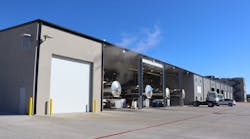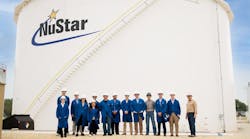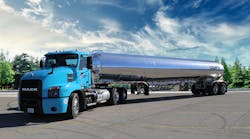Now that labor and management have finally reached an agreement at the West Coast ports, the obvious question FTR’s Larry Gross asks is: What next?
The importance of the ports on the US West Coast can hardly be overstated. In Q3 2014 (latest available data) these ports were responsible for over 52% of the nation’s containerized imports and over 38% of the containerized exports. These figures represent about 2.7 million import TEUs and 1.2 million export TEUs respectively.
How big is the backlog after the long shut down? At last report there were about 40 ships anchored off the West Coast awaiting berth space at the ports. If we assume an average size for these vessels of 8,000 TEU each, that indicates a total of roughly 320,000 TEUs that are floating on the water awaiting handling.
Assuming a typical mix of 40s and 20s this is perhaps 215,000 individual containers. And that doesn’t count the even more sizeable quantities of units on ships tied up at the docks and piled up in every inch of the terminals. This is probably at least as many as are on the water, so an informed guesstimate would be that perhaps 600,000 to 700,000 TEUs, or 400,000 to 500,000 individual containers are awaiting processing and movement.
How long might it take for this backlog to be worked down? For a rough idea, last year in March 2014, the major US West Coast ports (Los Angeles CA, Long Beach CA, Oakland CA, Portland OR, Seattle WA, and Tacoma WA) collectively handled a total of 710,000 inbound TEUs. This represents the inbound flow in a normal March. The flow in will undoubtedly be lower this March since most shippers were already diverting every load possible away from the chaos. Additionally, the late date of the Lunar New Year this year means that March import volumes would be lower than last year in any event. But even if volume declines by 20%, that leaves roughly 570,000 TEUs that probably will still hit the ports during the month and that number will ramp up seasonally each month thereafter.
The peak month last year was October for inbound shipments. During that month, the US West Coast ports handled a total of 872,000 TEUs, working flat out. This therefore represents a reasonable top-side estimate for how many containers can be processed, and implying an ability to work down the backlog to the tune of 250,000 to 300,000 TEU’s per month. So this “back of the envelope” calculation indicates that it will take eight weeks or more before things begin to approach “normal,” whatever that term means.
In the near term, we can expect spot rates off the West Coast to spike. This will be particularly true for expedited truck service as shippers will be desperate to make up for lost time and to deploy inventory on depleted store shelves and into assembly plants as soon as possible. Conversely, the currently elevated westbound rates will decline as carriers will be seeking every load available to deploy equipment back to the West Coast. The normally-high intermodal share of this volume will be somewhat reduced in light of the need for speed, but this effect will be swamped by the sheer volume increase that will occur.
What of the long term? Long-term damage has been done. Hanjin Lines has announced that after two years of conflict between labor and management at the main container terminal (privatized in 2010) and declining productivity it is discontinuing operations at the Port of Portland OR, thereby denying that port of two-thirds of its volume. This will cost an estimated 650 longshore workers their jobs.
While labor relations in the east are not by any stretch ideal, at least the last contract renewal was successfully completed without the extreme difficulties seen on the West Coast. The Northeast ports (New York/New Jersey, Norfolk VA), which had seen severe congestion issues last winter have taken a number of steps to improve operations and they are running more smoothly now. The Southeast Ports (Savannah GA, Charleston SC, Florida) have been running smoothly and efficiently, as has Houston TX.
Cargo has been diverted from the US West Coast all-water services via the Panama Canal and the Suez Canal to the East and Gulf Coasts. This will accelerate when the expanded Panama Canal opens next year. Freight is also being diverted to both western Canadian ports (Vancouver BC and Prince Rupert BC) and Mexican ports on the west coast. Some of these diversions will be permanent. From a land transport perspective the shift favors truck vs intermodal, as the hauls off the East Coast are far shorter and less intermodal-friendly than the long hauls from the West Coast to the Midwest.
Most important for cargo interests to understand is that the congestion problems will not disappear now that the contract is settled. There are deep-seated problems in the ports revolving around the peaking problems associated with the new mega-ships, chassis supply and the turmoil associated with the new shipping alliances. Additionally, it is highly likely that drayage carriers or the new chassis owners will challenge in court any provisions restricting who can inspect or maintain this equipment. These issues will take months if not years to work through.
A further question is whether anything was learned by labor and management from this debacle. Early indications are not promising. The previous West Coast port lockout in 2002 initiated a long-term share shift away from southern California, with big importers adopting a “four corner” or even “five corner” (Pacific Northwest, Southern California, Gulf, Southeast, Northeast) port strategy to diversify their supply chains and decrease risk. West Coast port labor and management promised a new era of stability, and that held for exactly one renewal of the six-year contract, but got lost in the shuffle this time around. Initial statements announcing the tentative contract agreement were notably lacking in any sense of remorse or apology for the disruptions that the protracted negotiations and hardball tactics had inflicted on innocent third parties. Now that the basic framework of the multi-corner import strategy is in place, further shift is more a matter of turning the dials than building something from scratch. So the involved parties on both sides of the conflict will end up paying dearly for having ignored the needs of the shipper who truly pays their bills.
Exporters are even more likely to suffer. Many of their commodities are agricultural or food-related and don’t lend themselves to the extended voyage times involved in all-water routings. They have much less ability to shift to other ports and are much more vulnerable to congestion.
Is there another solution? Although the port operators and dock labor are both well compensated for their efforts, the result are ports that are relatively inefficient, unproductive, and expensive by global standards, and while details are yet to be released, it is unlikely that there is anything in the new agreement that will change this.
So can the parochial concerns and esoteric squabbles of these two relatively minor players be prevented from wreaking havoc on the US economy in the future? The current available tools are relatively blunt and not particularly effective. The President can trigger federal intervention, but this simply mandates that the parties return to work during an 80-day “cooling off” period. The last time such an action occurred on the west coast was in 2002, when President Bush secured an injunction. In truth, during the crisis, intervention would have accomplished little other than the continuation of what was an already-unsatisfactory status quo.
One ultimate solution would be to place US longshore workers under the Railway Labor Act that already applies to railroad and airline workers. This would require congressional action for which little appetite apparently yet exists. And now that the immediate crisis has been settled the natural inclination of Congress will be to do exactly nothing. It will be up to shippers and those hurt by this crisis to build enough pressure to force action.
FTR will continue to monitor this situation closely and we will work to keep you informed of the implications as developments unfold in the coming weeks and months.








